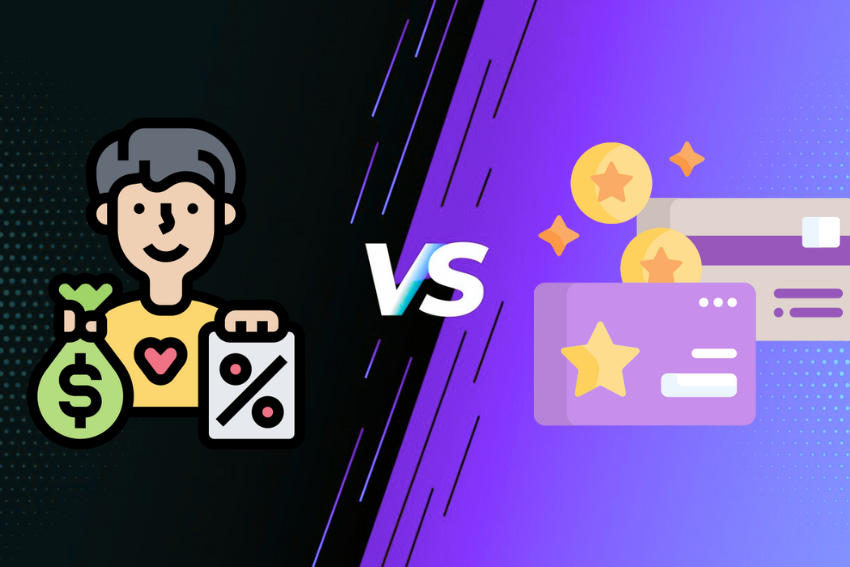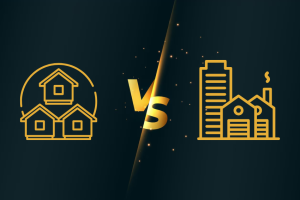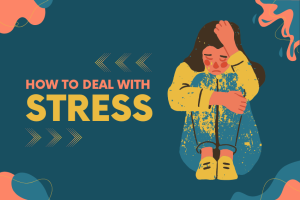Most individuals, when borrowing money would compare a personal loan vs credit card and decide which one to take as they are the cheaper of the two. The two are similar in the sense that they both offer fast access to funds, however, they are differentiated by interest rates, flexibility in repayment and general cost. It is important to appreciate these variations to make a smart financial choice that is in line with your needs and goals.

In this article, we are going to explore the advantages, the disadvantages, and the most important aspects to make your selection that will bring the most cost-effective value to your case.
What is a Personal Loan?
A personal loan is a form of unsecured loan that is provided by the banks, NBFCs and online lending. You do not need to offer any security or collateral. Thou borrow a lump sum amount and pay it back in fixed monthly EMIs (Equated Monthly Instalments) in a certain tenure period – normally 1 to 7 years.
The loan can be used for multiple purposes:
- Medical or emergency expenses.
- Home renovation.
- Travel or wedding costs.
- Debt consolidation.
- Education or relocation.
Example: If you take a ₹5 lakh personal loan at 12% for 3 years, you will pay ₹16,600 per month in EMIs.
What is a Credit Card?
Credit card is a sort of revolving credit card, which enables you to use it to a pre-established limit, and pay the sum afterward- either as a whole or in installments. It is convenient to buy groceries, gas/electricity, food, and online shopping. The interest free period of most credit cards is also up to 45-50 days on the condition that you clear your balance before the expiry date. But if you keep any balance, it will be charged a high interest rate (usually 3045 percent per year) on the balance required.
Credit cards are more than a payment tool, and they have added value of cashback, reward points, travel miles, discounts on brands and exclusive deals. They can be used wisely to establish a good credit history and provide financial flexibility on a short-term basis. However, when they are not dealt with properly, they may result in accumulating debt because of high interest and late charges.
Key Differences Between Personal Loan vs Credit Card
Let’s compare the two side by side for a quick overview:
| Feature | Personal Loan | Credit Card |
|---|---|---|
| Type of Credit | Term loan | Revolving credit |
| Interest Rate | 10%–20% per annum | 30%–45% per annum |
| Loan/Credit Limit | ₹50,000 – ₹40 lakh | ₹20,000 – ₹10 lakh |
| Repayment Tenure | 1–7 years | Monthly billing cycle |
| Collateral Required | No | No |
| Interest-Free Period | Not applicable | Up to 45–50 days |
| Disbursal Time | 1–3 days | Immediate |
| Repayment Mode | Fixed EMIs | Flexible (minimum or full payment) |
| Tax Benefits | No direct benefit (except for education/home renovation) | None |
| Usage | Large, planned expenses | Minor, repetitive or pro-rata costs. |
Interest Rate Comparison: The Determining Factor
When it comes to the decision of which option is cheaper, the interest rate is the most significant aspect to consider.
- Personal Loan Interest rate: It is usually around 10 to 20 per annum which depends on your income, credit rating, your lender, and the experience in your workplace.
- Credit Card Interest: The interest charge on unpaid balances is usually 30-45 percent per annum (2.5 to 3.75 percent monthly).
Example Comparison:
Let’s assume you borrow ₹1 lakh.
- Personal Loan (12% for 1 year): Total interest = ₹12,000 approx.
- Credit Card (36% for 1 year): Total interest = ₹36,000 approx.
That’s three times more expensive if you revolve your credit card balance!
Winner: Personal loan (cheaper for longer durations).
Repayment Structure
Personal Loan
Repayment of the loan is in Monthly fixed EMIs. The EMI does not change and hence it becomes easier to make your budget.
Late payments, though, have an impact on your credit rating and may draw penalties.
Credit Card
You can either:
- Pay the full amount due (no interest charged), or
- Minimum pay (interest that is charged on the remaining balance).
As much as the credit cards are flexible in nature, balances carried forward will soon turn into high-debt levels because of the interest that builds up.
Winner: Personal loan in place of financial discipline; credit card in place of short-term flexibility.
Loan Amount and Usage
Personal Loan
Suitable for large, one-time financial needs such as:
- Medical treatments
- Home repair or renovation
- Higher education
- Debt consolidation
- Weddings or big purchases
You can borrow anywhere between ₹50,000 to ₹40 lakh, depending on your eligibility and lender.
Credit Card
Designed for smaller, frequent, or emergency transactions, usually within your credit limit (₹20,000 – ₹10 lakh).
It is ideal for:
- Online purchases
- Travel bookings
- Utility payments
- Shopping or emergencies
Winner: Personal loan for large expenses; credit card for short-term or daily use.
Processing and Approval
Personal Loan
- In need of official documentation such as income evidence, bank statements, and KYC.
- It takes 24-48 hours to be approved (usually immediately with online lenders).
- There is a low processing charge (1 percent to 3 percent).
Credit Card
- Requires minimal documentation.
- Approval depends on your income, credit history, and existing relationships with the bank.
- Activation and credit limit approval are instant.
Winner: Credit card for instant approval; personal loan for higher value financing.
Fees and Additional Charges
Both personal loans and credit cards are related charges which influence the total cost of borrowing.
| Type of Charge | Personal Loan | Credit Card |
|---|---|---|
| Processing Fee | 1%–3% | 0%–3% (cash advance) |
| Prepayment Charges | 2%–4% of outstanding | None |
| Late Payment Fee | ₹500–₹1000 | ₹100–₹1300 |
| Annual Fee | None | ₹500–₹5,000 (depending on card) |
| Cash Withdrawal Fee | Not applicable | 2%–3.5% per transaction |
| Interest-Free Period | Not available | Up to 45–50 days |
Winner: Personal loan (lower ongoing fees and predictable cost).
Impact on Credit Score
Both options can impact your CIBIL score or credit profile depending on usage:
- Personal Loan: Timely EMI payments boost your credit score. Missing EMIs can bring it down.
- Credit Card: It is better to keep your credit use to less than 30 percent and pay all bills on schedule to improve your score.
- Delays and excessive usage may badly damage your credit score.
Winner: Both have the ability to assist or damage, based on the behavior of repayment.
Advantages and Disadvantages
The benefits and the drawbacks of the two options would be useful to be isolated.
Advantages of Personal Loan
- Reduction in the Interest rates: Cheaper long-term borrowing.
- Foreseeable EMIs: Easy to calculate finances.
- Growing Loan Amounts: Appropriate in case of major life situations or in case of emergencies.
- Fixed Term: Promotes Disciplined Repayment.
- Non-End-Use Restriction: You may use it in anything.
Disadvantages Of Personal Loan
- Processing Time The longest among the cards is longer than credit card approval.
- Prepayment Penalty: There are those lenders who charge their clients on premature termination.
- Fixed Repayment Schedule: Not as flexible as credit cards.
Advantages Of Credit Card
- Fast Money: Anywhere, anytime.
- Interest-Free Period: In case paid within the 50 days stipulated time.
- Rewards & Cashback: Get benefits on all the transactions.
- Builds Credit History: Excellent for improving credit score.
- Convenience: Safe for online and offline purchases.
Disadvantages Of Credit Card
- High Interest Rates: Expensive in case of balances which have not been paid.
- Unidentified Dues: Annual fees, late charges, and penalties.
- Easy to fall into debt traps: Risk of Overspending.
- Complex Billing: Mismanagement can lead to compounding interest.
Tax Implications
- Personal Loan: No tax benefits. However, if used for education, business, or home renovation, interest paid can qualify for deductions under Section 80E or 24(b).
- Credit Card: No tax benefits. Rewards or cashback are not taxable unless used for business purposes.
Winner: Personal loan (if used for eligible purposes).
When to Choose a Personal Loan?
A personal loan is the appropriate option when you:
- Requirement of big amounts of money (1 lakh to 20 lakh or so).
- I want predictable EMIs and tenure.
- Have a consistent income and ability to pay.
- I intend to amalgamate several high-interest debts.
- Want lower overall interest costs over time.
Example:
If you owe 2 lakhs on your credit card with an interest rate of 36 per cent, then by moving it to a 12 per cent loan, you save 48000 every year in interest!
When to Choose a Credit Card?
A credit card is ideal when:
- You need short-term funds or manage recurring expenses.
- You can repay within the interest-free period.
- You want rewards, cashback, or travel perks.
- You need quick access to money in emergencies.
Example:
You can use a credit card to book emergency travel or pay medical bills instantly, then repay the full amount in the next cycle — paying zero interest.
Wise Tip: Use The Two Together Wisely
Financially clever individuals borrow both personal loans and credit cards intelligently.
- Use credits in short-term purchases and rewards.
- Personal loans should be used for big and long-term costs.
- When there is a credit card debt with high interest rates, borrow money at a low interest and use it to settle the high-interest debt.
This method will save you interest, a high credit score, and stable finances.
Real Life Application: Case Study
Let’s say you need ₹3 lakh urgently. You have two choices:
Personal Loan:
- Interest Rate: 12% p.a.
- Tenure: 3 years
- EMI: ₹9,956
- Total Interest: ₹58,000 approx.
Credit Card:
- Interest Rate: 36% p.a.
- Pay ₹15,000 per month.
- Total Interest (for 2 years): ₹1.1 lakh approx.
Verdict: You save ₹52,000 by opting for a personal loan instead of a credit card balance.
Future Trends: Personal Loans vs Credit Cards
With growing digital lending ecosystem, both personal loans and credit cards are evolving:
- Instant Digital Personal Loans: FinTech like Cred, Paytm, and Navi offer approval within minutes.
- BNPL (Buy Now, Pay Later): Short-term credit like credit cards but with lower limits.
- Low-Interest Cards: Some banks are introducing cards with 12%–18% annual interest to compete with personal loans.
The line between these two products is blurring, giving borrowers more flexible choices than ever.
Conclusion: Which Finance Option Is Cheaper?
In comparison with personal loan and credit card, the appropriate option is primarily dependent on your financial requirements and payment status. The choice of personal loans is usually superior in case of high costs like home renovation, medical emergencies, or debt consolidation as it has lower interest rates and monthly payments which are fixed and on a long-term basis. It offers a stable flow and fixed repayment patterns thereby making it easy to budget.
In contrast, credit cards are more suitable for short-term or everyday purchases like shopping, traveling, or dining out, especially if you can repay the loan interest-free within 45-50 days. However, they are a more expensive source of credit because the interest rate on transferred balances is higher (30-45% per annum).
It is the most intelligent solution to employ both wisely, credit cards to use in the short run and loan money to afford long term. When used prudently, they will be a fruitful complement to each other, to create financial discipline and enhance your credit profile.


